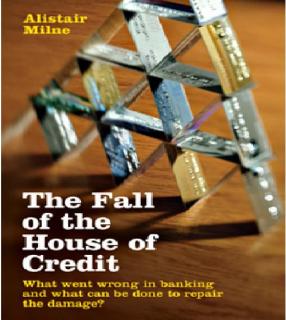Contents
List of figures x
List of tables xi
List of boxes xii
Acknowledgements xiii
Introduction 1
1 Where did all the money go? An analysis of the causes
and cure of the current global banking crisis 24
Presents the argument of the book, that a policy of holding safe but illiquid long-term structured credit securities, financed using short-term borrowing, created a bank funding crisis that was the principal mechanism creating the credit crisis. Presents a key Figure 1.1, which illustrates this new feedback loop in wholesale funding markets that makes this crisis different from any others. Compares other analyses of the crisis and argues that it can be addressed through a policy of taxpayers providing insurance against extreme systemic credit losses. Considers some practical details.
2 Build-up, meltdown and intervention 50
The macroeconomics of the story and the role of banks in recycling global savings. The threat of a massive global economic downturn if this recycling is not maintained. An overview of bank involvement in the structured credit markets. An estimate of the amount of exposure and some projections of prospective losses, distinguishing permanent credit impairment from short-term liquidity losses. An overview of actions taken by policymakers.
3 We have been here before, haven't we? 83
A brief comparison of this crisis with Scandinavia, Japan and the Asian crises of 1997, Latin American lending and some other examples of financial panics.
4 A basic funding tool - the tranched mortgage-backed security 118
Explains the mechanics of the tranched mortgage-backed security and similar instruments. Compares them with corporate bonds. Shows how tranching is used to concentrate the risk, creating a large amount of default-risk-free paper. Looks at how Countrywide used these securities to fund its lending and at one particular sub-prime securitization in detail.
5 Using tranching to make short-term transaction profits 143
Examines how the basic structure was used for very different purposes, for short-term transaction deals backed by high-yield but high-risk portfolios. How these deals work well in an upturn but are no longer attractive in a downturn. Explains CDO, CLO and so on, including more suspect complex deals. Looks at one particular CLO. Quantifies both where the money went and discusses who was holding it.
6 Borrowing short and lending long: the illusion of
liquidity in structured credit 170
Describes the fundamental failing of the new credit markets, the failure to sell the new credit instruments to long-term investors and the decision instead by banks to hold them as 'trading instruments' financed with short-term borrowing. Looks at the use of off balance sheet vehicles such as conduits and SIVs, noting that they provided only a proportion of the short-term financing, repo being much more widely used.
7 The levees break 195
A narrative of the first phases, from late 2006 until the rescue of Northern Rock. Documents the worldwide
impact of the initial losses on US sub-prime. Structured credit markets became illiquid, resulting in write-offs of many bank portfolios. The disruption of money markets and global impact.
8 The flood of losses 220
The narrative continued, up to the failure of AIG. A series of case studies both discusses the major losses experienced by many individual institutions (UBS, Merrill, Citigroup, Fannie and Freddie, AIG) and provides an overview of losses across the banking sector. Discusses also many of the knock-on effects on monolines and municipal bond markets.
9 Central banks and money markets 257
Goes into the details of central bank monetary and liquidity operations, pointing out the limitations of central bank liquidity provision. Explains how banks use money markets to raise short-term funding. Compares orthodox and unorthodox approaches to monetary policy. Notes that there are substantial limits on the ability of central banks to provide commercial banks with new funds for lending.
10 The run on the world's banks 285
The failure of Lehman and the four-week run on the global banking system and government rescues that followed. An assessment of the policy measures taken, showing how they are moving in the direction of taxpayer provision of long-term systemic risk insurance.
Conclusions: repairing the house of credit 314
Explains how a global slump can be avoided and briefly considers longer-term measures to restore global prosperity.
Glossary 341 Index 357

